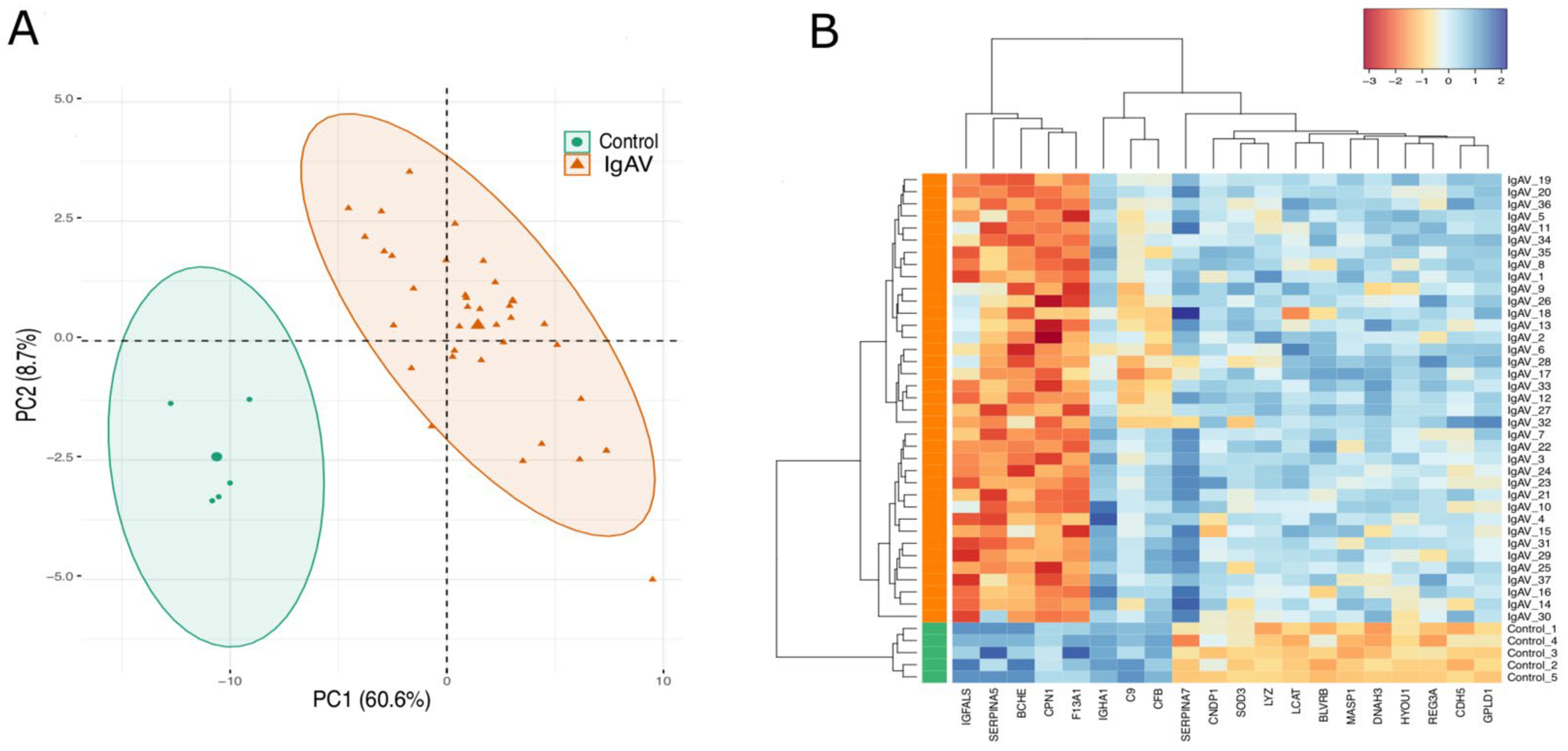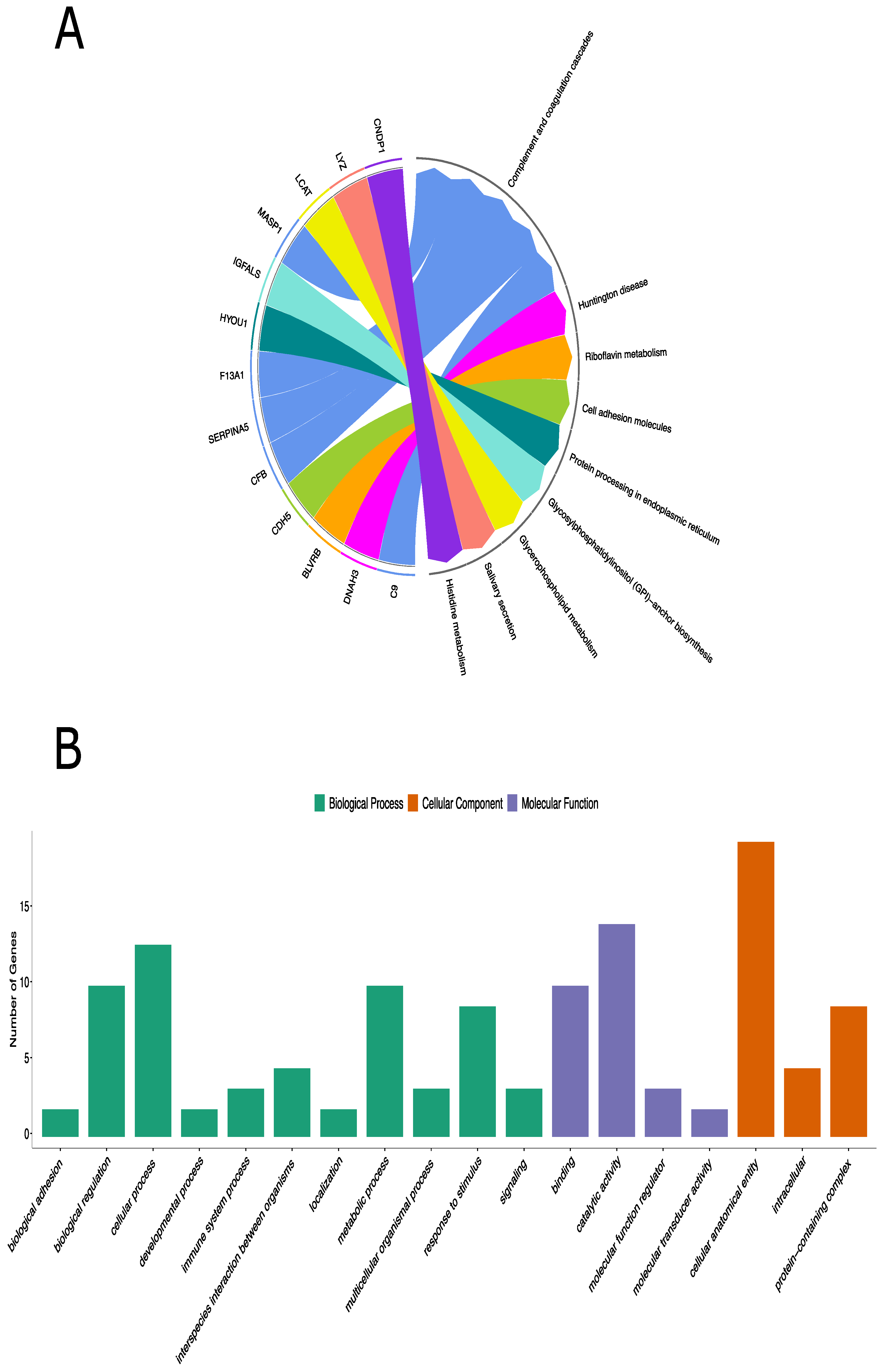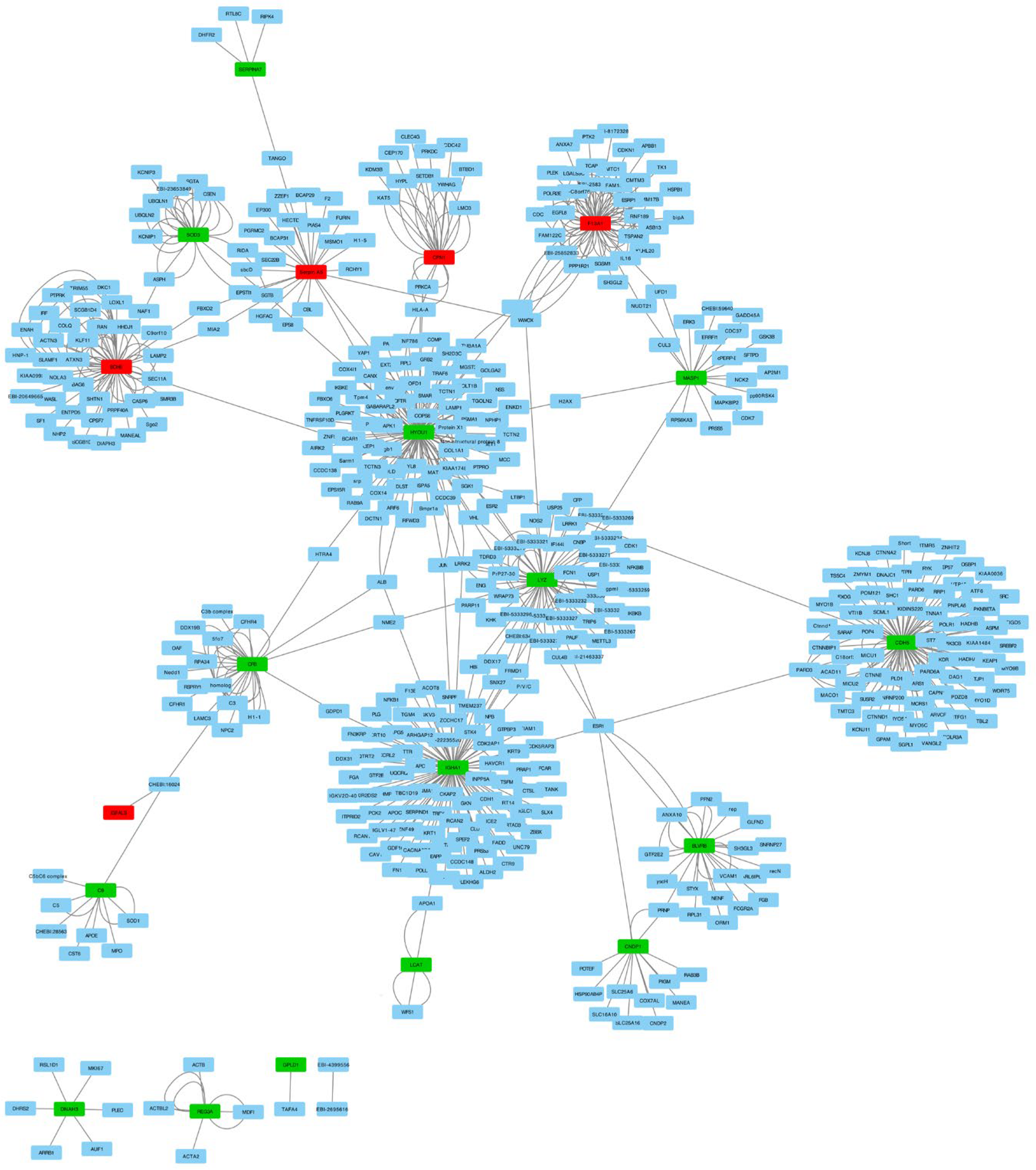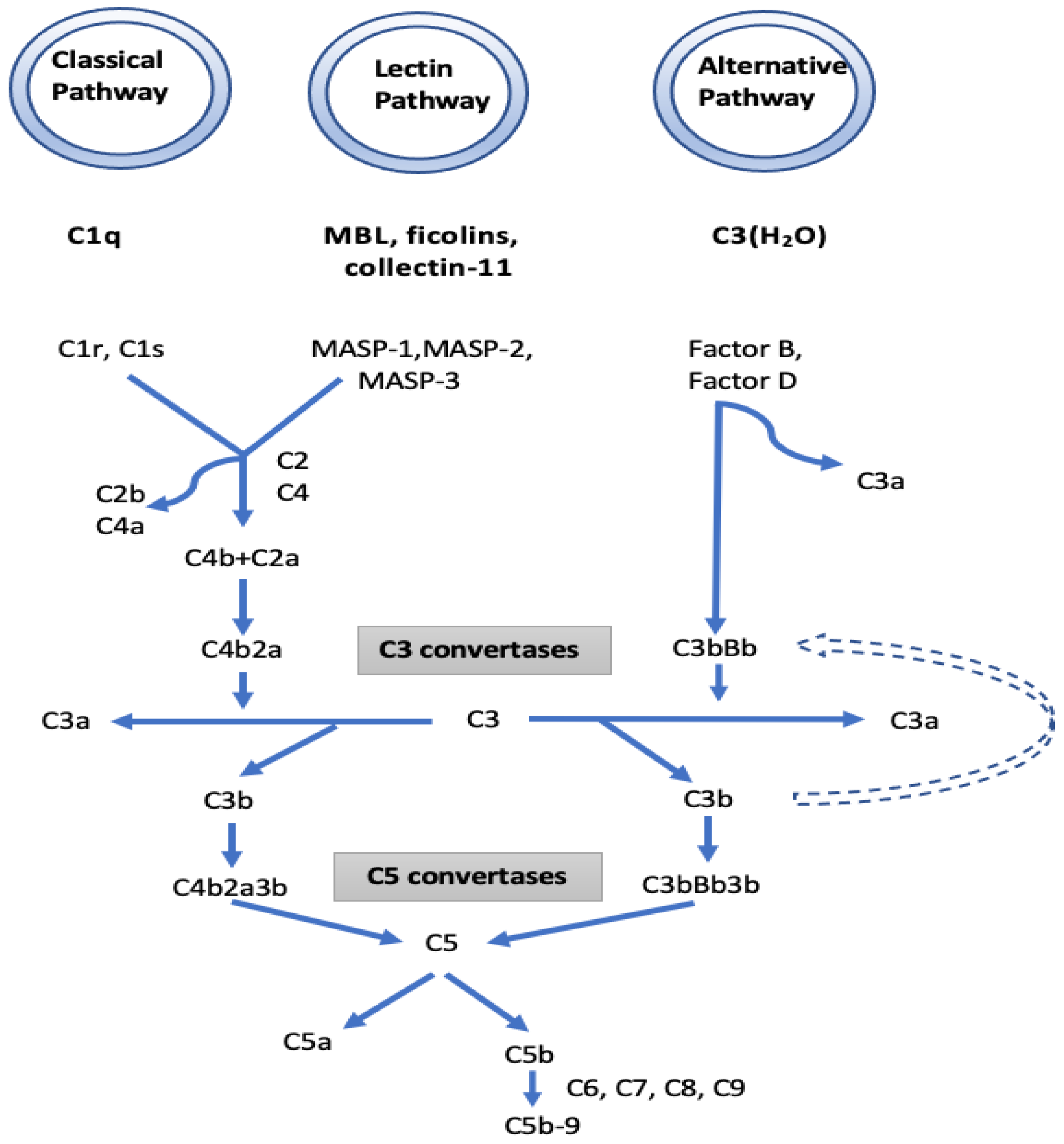Plasma Proteomic Analysis Reveals the Potential Role of Lectin and Alternative Complement Pathways in IgA Vasculitis Pathogenesis
Abstract
:1. Introduction
2. Materials and Methods
2.1. Patient Selection and Sample Collection
2.2. Protein Identification and Bioinformatic Analyses
2.3. Protein Quantification Analysis and Functional Annotation Analysis
3. Results
3.1. Demographic and Clinical Characteristics
3.2. Proteomic Profiling
3.3. KEGG and Reactome Pathway Analysis of the Differentially Expressed Proteins
3.4. Panther Classification Analysis and GO Functional Analysis of the Differentially Expressed Proteins
4. Discussion
Supplementary Materials
Author Contributions
Funding
Institutional Review Board Statement
Informed Consent Statement
Data Availability Statement
Conflicts of Interest
References
- Jennette, J.C.; Falk, R.J.; Bacon, P.A.; Basu, N.; Cid, M.C.; Ferrario, F.; Flores-Suarez, L.F.; Gross, W.L.; Guillevin, L.; Hagen, E.C.; et al. 2012 revised International Chapel Hill Consensus Conference Nomenclature of Vasculitides. Arthritis Rheum. 2013, 65, 1–11. [Google Scholar] [CrossRef] [PubMed]
- Coppo, R.; Mazzucco, G.; Cagnoli, L.; Lupo, A.; Schena, F.P. Long-term prognosis of Henoch-Schonlein nephritis in adults and children. Italian Group of Renal Immunopathology Collaborative Study on Henoch-Schonlein purpura. Nephrol. Dial. Transplant. 1997, 12, 2277–2783. [Google Scholar] [CrossRef] [PubMed]
- Allen, A.C.; Willis, F.R.; Beattie, T.J.; Feehally, J. Abnormal IgA glycosylation in Henoch-Schonlein purpura restricted to patients with clinical nephritis. Nephrol. Dial. Transplant. 1998, 13, 930–934. [Google Scholar] [CrossRef]
- Novak, J.; Rizk, D.; Takahashi, K.; Zhang, X.; Bian, Q.; Ueda, H.; Ueda, Y.; Reily, C.; Lai, L.-Y.; Hao, C.; et al. New Insights into the Pathogenesis of IgA Nephropathy. Kidney Dis. 2015, 1, 8–18. [Google Scholar] [CrossRef]
- Heineke, M.H.; Ballering, A.V.; Jamin, A.; Ben Mkaddem, S.; Monteiro, R.C.; Van Egmond, M. New insights in the pathogenesis of immunoglobulin A vasculitis (Henoch-Schonlein purpura). Autoimmun. Rev. 2017, 16, 1246–1253. [Google Scholar] [CrossRef]
- He, X.; Yin, W.; Ding, Y.; Cui, S.J.; Luan, J.; Zhao, P.; Yue, X.; Yu, C.; Laing, X.; Zhao, Y. Higher Serum Angiotensinogen Is an Indicator of IgA Vasculitis with Nephritis Revealed by Comparative Proteomes Analysis. PLoS ONE 2015, 10, e0130536. [Google Scholar] [CrossRef] [PubMed]
- Xie, B.; Zhang, W.; Zhang, Q.; Zhang, Q.; Wang, Y.; Sun, L.; Liu, M.; Zhou, P. An Integrated Transcriptomic and Proteomic Analysis Identifies Significant Novel Pathways for Henoch-Schonlein Purpura Nephritis Progression. BioMed Res. Int. 2020, 2020, 2489175. [Google Scholar] [CrossRef]
- Sun, L.; Xie, B.; Zhang, Q.; Wang, Y.; Wang, X.; Gao, B.; Liu, M.; Wang, M. Biomarkers identification by a combined clinical and metabonomics analysis in Henoch-Schonlein purpura nephritis children. Oncotarget 2017, 8, 114239. [Google Scholar] [CrossRef]
- Jia, L.; Wu, J.; Wei, J.; Du, L.; Wang, P.; Zhang, Y.; Yu, Y.; Wang, X.; Yang, Y.; Gao, Y. Proteomic analysis of urine reveals biomarkers for the diagnosis and phenotyping of abdominal-type Henoch-Schonlein purpura. Transl. Pediatr. 2021, 10, 510. [Google Scholar] [CrossRef]
- Demir, S.; Kaplan, O.; Celebier, M.; Sag, E.; Bilginer, Y.; Lay, I.; Ozen, S. Predictive biomarkers of IgA vasculitis with nephritis by metabolomic analysis. Semin. Arthritis Rheum. 2020, 50, 1238–1244. [Google Scholar] [CrossRef]
- Ozen, S.; Pistorio, A.; Iusan, S.M.; Bakkaloglu, A.; Herlin, T.; Brik, R.; Buoncompagni, A.; Lazar, C.; Bilge, I.; Uziel, Y.; et al. EULAR/PRINTO/PRES criteria for Henoch-Schonlein purpura, childhood polyarteritis nodosa, childhood Wegener granulomatosis and childhood Takayasu arteritis: Ankara 2008. Part II: Final classification criteria. Ann. Rheum. Dis. 2010, 69, 798–806. [Google Scholar] [CrossRef] [PubMed]
- Tyanova, S.; Temu, T.; Cox, J. The MaxQuant computational platform for mass spectrometry-based shotgun proteomics. Nat. Protoc. 2016, 11, 2301–2319. [Google Scholar] [CrossRef] [PubMed]
- Tyanova, S.; Temu, T.; Sinitcyn, P.; Carlson, A.; Hein, M.Y.; Geiger, T.; Mann, M.; Cox, J. The Perseus computational platform for comprehensive analysis of (prote) omics data. Nat. Methods 2016, 13, 731–740. [Google Scholar] [CrossRef] [PubMed]
- Thomas, P.D.; Campbell, M.J.; Kejariwal, A.; Mi, H.; Karlak, B.; Daverman, R.; Diemer, K.; Muruganujan, A.; Narechania, A. PANTHER: A library of protein families and subfamilies indexed by function. Genome Res. 2003, 13, 2129–2141. [Google Scholar] [CrossRef]
- Kanehisa, M.; Goto, S. KEGG: Kyoto encyclopedia of genes and genomes. Nucleic Acids Res. 2000, 28, 27–30. [Google Scholar] [CrossRef]
- Jassal, B.; Matthews, L.; Viteri, G.; Gong, C.; Lorente, P.; Fabregat, A.; Sidiropoulos, K.; Cook, J.; Gillespie, M.; Haw, R.; et al. The reactome pathway knowledgebase. Nucleic Acids Res. 2020, 48, D498–D503. [Google Scholar] [CrossRef]
- Shannon, P.; Markiel, A.; Ozier, O.; Baliga, N.S.; Wang, J.T.; Ramage, D.; Amin, N.; Schwikowski, B.; Ideker, T. Cytoscape: A software environment for integrated models of biomolecular interaction networks. Genome Res. 2003, 13, 2498–2504. [Google Scholar] [CrossRef]
- Kerrien, S.; Aranda, B.; Breuza, L.; Bridge, A.; Broackes-Carter, F.; Chen, C.; Duesbury, M.; Dumousseau, M.; Feuermann, M.; Hinz, U.; et al. The IntAct molecular interaction database in 2012. Nucleic Acids Res. 2012, 40, D841–D846. [Google Scholar] [CrossRef]
- Ehrnthaller, C.; Ignatius, A.; Gebhard, F.; Huber-Lang, M. New insights of an old defense system: Structure, function, and clinical relevance of the complement system. Mol. Med. 2011, 17, 317–329. [Google Scholar] [CrossRef]
- Roos, A.; Rastaldi, M.P.; Calvaresi, N.; Oortwijn, B.D.; Schlagwein, N.; van Gijlswijk-Janssen, D.J.; Stahl, G.L.; Matsushita, M.; Fujita, T.; Van Kooten, C.; et al. Glomerular activation of the lectin pathway of complement in IgA nephropathy is associated with more severe renal disease. J. Am. Soc. Nephrol. 2006, 17, 1724–1734. [Google Scholar] [CrossRef]
- Damman, J.; Mooyaart, A.L.; Bosch, T.; Seelen, M.A.; Doorn, M.B.V. Lectin and alternative complement pathway activation in cutaneous manifestations of IgA-vasculitis: A new target for therapy? Mol. Immunol. 2022, 143, 114–121. [Google Scholar] [CrossRef]
- Katafuchi, R.; Nagae, H.; Masutani, K.; Tsuruya, K.; Mitsuiki, K. Comprehensive evaluation of the significance of immunofluorescent findings on clinicopathological features in IgA nephropathy. Clin. Exp. Nephrol. 2019, 23, 169–181. [Google Scholar] [CrossRef]
- Kim, S.J.; Koo, H.M.; Lim, B.J.; Oh, H.J.; Yoo, D.E.; Shin, D.H.; Lee, M.J.; Doh, F.M.; Park, J.T.; Yoo, T.H.; et al. Decreased circulating C3 levels and mesangial C3 deposition predict renal outcome in patients with IgA nephropathy. PLoS ONE 2012, 7, e40495. [Google Scholar] [CrossRef] [PubMed]
- Bellur, S.S.; Troyanov, S.; Cook, H.T.; Roberts, I.S.; Working Group of International IgA Nephropathy Network and Renal Pathology Society. Immunostaining findings in IgA nephropathy: Correlation with histology and clinical outcome in the Oxford classification patient cohort. Nephrol. Dial. Transplant. 2011, 26, 2533–2536. [Google Scholar] [CrossRef] [PubMed]
- Noris, M.; Remuzzi, G. Overview of complement activation and regulation. Semin Nephrol. 2013, 33, 479–492. [Google Scholar] [CrossRef] [PubMed]
- Maillard, N.; Wyatt, R.J.; Julian, B.A.; Kiryluk, K.; Gharavi, A.; Fremeaux-Bacchi, V.; Novak, J. Current Understanding of the Role of Complement in IgA Nephropathy. J. Am. Soc. Nephrol. 2015, 26, 1503–1512. [Google Scholar] [CrossRef] [PubMed]
- Oortwijn, B.D.; Roos, A.; Royle, L.; van Gijlswijk-Janssen, D.J.; Faber-Krol, M.C.; Eijgenraam, J.W.; Dwek, R.A.; Daha, M.R.; Rudd, P.M.; van Kooten, C. Differential glycosylation of polymeric and monomeric IgA: A possible role in glomerular inflammation in IgA nephropathy. J. Am. Soc. Nephrol. 2006, 17, 3529–3539. [Google Scholar] [CrossRef] [PubMed]
- Quast, I.; Lunemann, J.D. Fc glycan-modulated immunoglobulin G effector functions. J. Clin. Immunol. 2014, 34 (Suppl. S1), S51–S55. [Google Scholar] [CrossRef] [PubMed]
- Paunas, T.I.F.; Finne, K.; Leh, S.; Marti, H.P.; Mollnes, T.E.; Berven, F.; Vikse, B.E. Glomerular abundance of complement proteins characterized by proteomic analysis of laser-captured microdissected glomeruli associates with progressive disease in IgA nephropathy. Clin. Proteom. 2017, 14, 30. [Google Scholar] [CrossRef]
- Selvaskandan, H.; Kay Cheung, C.; Dormer, J.; Wimbury, D.; Martinez, M.; Xu, G.; Barratt, J. Inhibition of the Lectin Pathway of the Complement System as a Novel Approach in the Management of IgA Vasculitis-Associated Nephritis. Nephron 2020, 144, 453–458. [Google Scholar] [CrossRef]
- Patel, D.M.; Cantley, L.; Moeckel, G.; Dahl, N.K.; Luciano, R. IgA vasculitis complicated by acute kidney failure with thrombotic microangiopathy: Successful use of eculizumab. J. Nephrol. 2021, 34, 2141–2145. [Google Scholar] [CrossRef] [PubMed]
- Rizk, D.V.; Maillard, N.; Julian, B.A.; Knoppova, B.; Green, T.J.; Novak, J.; Wyatt, R.J. The Emerging Role of Complement Proteins as a Target for Therapy of IgA Nephropathy. Front. Immunol. 2019, 10, 504. [Google Scholar] [CrossRef] [PubMed]
- Clayton, A.; Harris, C.L.; Court, J.; Mason, M.D.; Morgan, B.P. Antigen-presenting cell exosomes are protected from complement-mediated lysis by expression of CD55 and CD59. Eur. J. Immunol. 2003, 33, 522–531. [Google Scholar] [CrossRef]
- Xiao, H.F.; Dong, Z.G.; Xu, W.Q.; Chen, X.Y.; Xin, P.L.; Zhang, J.Y. Evaluation and Comparison of Thromboelastography and Conventional Coagulation Tests for Blood Coagulation Function in Children with Henoch-Schonlein Purpura. Zhongguo Shi Yan Xue Ye Xue Za Zhi 2019, 27, 850–854. [Google Scholar] [PubMed]
- Krarup, A.; Gulla, K.C.; Gal, P.; Hajela, K.; Sim, R.B. The action of MBL-associated serine protease 1 (MASP1) on factor XIII and fibrinogen. Biochim. Biophys. Acta 2008, 1784, 1294–1300. [Google Scholar] [CrossRef]
- Habibagahi, Z.; Habibagahi, M.; Heidari, M. Raised concentration of soluble form of vascular endothelial cadherin and IL-23 in sera of patients with Behcet’s disease. Mod. Rheumatol. 2010, 20, 154–159. [Google Scholar] [CrossRef]
- Dursun, I.; Dusunsel, R.; Poyrazoglu, H.M.; Gunduz, Z.; Patiroglu, T.; Ulger, H.; Gurgoze, M.K. Circulating endothelial microparticles in children with Henoch-Schonlein purpura; preliminary results. Rheumatol. Int. 2011, 31, 1595–1600. [Google Scholar] [CrossRef] [PubMed]
- Chen, T.; Guo, Z.P.; Cao, N.; Qin, S.; Li, M.M.; Jia, R.Z. Increased serum levels of soluble vascular endothelial-cadherin in patients with systemic vasculitis. Rheumatol. Int. 2014, 34, 1139–1143. [Google Scholar] [CrossRef]
- Ueki, I.; Ooi, G.T.; Tremblay, M.L.; Hurst, K.R.; Bach, L.A.; Boisclair, Y.R. Inactivation of the acid labile subunit gene in mice results in mild retardation of postnatal growth despite profound disruptions in the circulating insulin-like growth factor system. Proc. Natl. Acad. Sci. USA 2000, 97, 6868–6873. [Google Scholar] [CrossRef]
- Succurro, E.; Andreozzi, F.; Sciacqua, A.; Hribal, M.L.; Perticone, F.; Sesti, G. Reciprocal association of plasma IGF-1 and interleukin-6 levels with cardiometabolic risk factors in nondiabetic subjects. Diabetes Care. 2008, 31, 1886–1888. [Google Scholar] [CrossRef]
- Sun, C.; Wang, X.; Hui, Y.; Fukui, H.; Wang, B.; Miwa, H. The Potential Role of REG Family Proteins in Inflammatory and Inflammation-Associated Diseases of the Gastrointestinal Tract. Int. J. Mol. Sci. 2021, 22, 7196. [Google Scholar] [CrossRef] [PubMed]
- Darnaud, M.; Dos Santos, A.; Gonzalez, P.; Augui, S.; Lacoste, C.; Desterke, C.; De Hertogh, G.; Valentino, E.; Braun, E.; Zheng, J.; et al. Enteric Delivery of Regenerating Family Member 3 alpha Alters the Intestinal Microbiota and Controls Inflammation in Mice with Colitis. Gastroenterology 2018, 154, 1009–1023. [Google Scholar] [CrossRef] [PubMed]
- Matturri, L.; Ghidoni, P.; Palazzi, P.; Stasi, P. Renal allograft rejection: Immunohistochemistry of inflammatory cellular subsets and vascular lesions. Basic Appl. Histochem. 1986, 30, 267–277. [Google Scholar] [PubMed]
- Park, J.S.; Kang, M.I.; Ha, Y.J.; Song, J.J.; Park, Y.B.; Lee, S.K.; Lee, S.W. Serum anti-lysozyme is associated with disease activity of Behcet’s disease. Int. J. Rheum. Dis. 2017, 20, 261–268. [Google Scholar] [CrossRef]




| Gene Name | Protein Name | IgAV vs. Control (Fold Change) | KEGG Pathway | Function |
|---|---|---|---|---|
| MASP1 | Mannose-binding lectin-associated serine protease 1 | 13.46 | Complement and coagulation cascades | Lectin pathway of complement activation/coagulation pathway |
| CFB | Complement factor B | 1.72 | Complement and coagulation cascades | Alternate pathway of complement activation |
| SERPINA5 | Plasma serine protease inhibitor | −3.7 | Complement and coagulation cascades | Inhibit several serine proteases; hemostasis/thrombosis/complement activation pathways |
| C9 | Complement C9 | 1.99 | Complement and coagulation cascades | Constituent of membrane attack complex (MAC) |
| SERPINA7 | Thyroxine-binding globulin | 19.46 | ||
| FXIIIA1 (F13A1) | Coagulation factor XIII a-chain | −5 | Complement and coagulation cascades | Fibrin stabilizing |
| REG3A | Regenerating family member 3 alpha | 14.29 | Innate Immune system | |
| GPLD1 | Glycosylphosphatidylinositol-specific phospholipase D1 | 14.72 | ||
| LCAT | Lecithin–cholesterol acyltransferase | 12.95 | Glycerophospholipid metabolism | |
| SOD3 | Superoxide dismutase 3 | 13.69 | Antioxidant | |
| HYOU1 | Hypoxia upregulated 1 | 10.28 | Protein processing in endoplasmic reticulum | Hypoxia chaperone |
| DNAH3 | Dynein axonemal heavy chain 3, | 13.65 | Huntington disease | |
| CDH5 | Cadherin 5 | 13.67 | Cell adhesion molecules | Endothelial adherens junction assembly and maintenance |
| IGFALS | Insulin-like growth factor-binding protein acid labile subunit | −4.28 | Glycosylphosphatidylinositol (GPI)-anchor biosynthesis | Cell adhesion |
| CNDP1 | Carnosine dipeptidase 1 | 12.19 | Histidine metabolism | Beta-alanine metabolism |
| BCHE | Butyrylcholinesterase | −5.08 | ||
| CPN1 | Carboxypeptidase N subunit 1 | −2.84 | Anaphylatoxin inactivator; protects the body from potent vasoactive and inflammatory peptides | |
| LYZ | Lysozyme C | 13.72 | Salivary secretion | |
| BLVRB | Flavin reductase | 10.79 | Riboflavin metabolism | Heme metabolism |
| IGHA1 | Immunoglobulin heavy constant alpha 1 | 1.98 | Immune system, immunoglobulin receptor binding |
Disclaimer/Publisher’s Note: The statements, opinions and data contained in all publications are solely those of the individual author(s) and contributor(s) and not of MDPI and/or the editor(s). MDPI and/or the editor(s) disclaim responsibility for any injury to people or property resulting from any ideas, methods, instructions or products referred to in the content. |
© 2023 by the authors. Licensee MDPI, Basel, Switzerland. This article is an open access article distributed under the terms and conditions of the Creative Commons Attribution (CC BY) license (https://creativecommons.org/licenses/by/4.0/).
Share and Cite
Demir, S.; Yet, I.; Sardan Ekiz, M.; Sag, E.; Bilginer, Y.; Celikbicak, O.; Lay, I.; Ozen, S. Plasma Proteomic Analysis Reveals the Potential Role of Lectin and Alternative Complement Pathways in IgA Vasculitis Pathogenesis. Diagnostics 2023, 13, 1729. https://doi.org/10.3390/diagnostics13101729
Demir S, Yet I, Sardan Ekiz M, Sag E, Bilginer Y, Celikbicak O, Lay I, Ozen S. Plasma Proteomic Analysis Reveals the Potential Role of Lectin and Alternative Complement Pathways in IgA Vasculitis Pathogenesis. Diagnostics. 2023; 13(10):1729. https://doi.org/10.3390/diagnostics13101729
Chicago/Turabian StyleDemir, Selcan, Idil Yet, Melis Sardan Ekiz, Erdal Sag, Yelda Bilginer, Omur Celikbicak, Incilay Lay, and Seza Ozen. 2023. "Plasma Proteomic Analysis Reveals the Potential Role of Lectin and Alternative Complement Pathways in IgA Vasculitis Pathogenesis" Diagnostics 13, no. 10: 1729. https://doi.org/10.3390/diagnostics13101729





